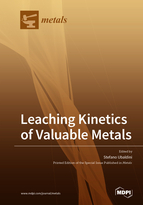Leaching Kinetics of Valuable Metals
A special issue of Metals (ISSN 2075-4701). This special issue belongs to the section "Extractive Metallurgy".
Deadline for manuscript submissions: closed (31 October 2020) | Viewed by 48308
Special Issue Editor
Interests: primary and secondary raw materials; low-grade georesources; metals recovery; precious metals; heavy metals; leaching; hydrometallurgy; bio-hydrometallurgy; bioprecipitation; electrowinning; remediation processes; environmental innovative technologies; industrial wastes; exhausted batteries; WEEE; minerals; wastewater; acid mine drainage
Special Issues, Collections and Topics in MDPI journals
Special Issue Information
Dear Colleagues,
Leaching is a primary extractive operation in hydrometallurgical processing, by which a metal of interest is transferred from naturally-occurring minerals into an aqueous solution. In essence, it involves the selective dissolution of valuable minerals, where the ore, concentrate, or matte is brought into contact with an active chemical solution known as a leach solution.
Currently, the hydrometallurgical processes have a great application, not only in the mining sector—in particular, for the recovery of precious metals, such as gold and silver—but also in the environmental sector, for the recovery of toxic metals (such as copper, nickel, zinc, manganese, arsenic, cadmium, chromium, lead) from wastes of various types, and their reuse as valuable metals, after purification.
Therefore, there is an increasing need to develop novel solutions, to implement environmentally sustainable practices in the recovery of these valuable and precious metals, with particular reference to the critical metals, that are those included in materials that are indispensable to modern life and for which an exponential increase in consumption is already a reality or will be in a short-term perspective (antimony, indium, vanadium, rare hearts, etc.).
Consequently, the economics of the processes, which is closely linked to the kinetics of leaching, is of great importance.
For publication in this Special Issue, will be considered those articles that will contribute to the optimization of the kinetic conditions of innovative hydrometallurgical processes—economic and of low environmental impact—applied for the recovery of valuable and critical metals.
I hope you accept this invitation, and help us to make a high-impact and high-quality Special Issue on "Leaching Kinetics of Valuable Metals".
Dr. Stefano Ubaldini
Guest Editor
Manuscript Submission Information
Manuscripts should be submitted online at www.mdpi.com by registering and logging in to this website. Once you are registered, click here to go to the submission form. Manuscripts can be submitted until the deadline. All submissions that pass pre-check are peer-reviewed. Accepted papers will be published continuously in the journal (as soon as accepted) and will be listed together on the special issue website. Research articles, review articles as well as short communications are invited. For planned papers, a title and short abstract (about 100 words) can be sent to the Editorial Office for announcement on this website.
Submitted manuscripts should not have been published previously, nor be under consideration for publication elsewhere (except conference proceedings papers). All manuscripts are thoroughly refereed through a single-blind peer-review process. A guide for authors and other relevant information for submission of manuscripts is available on the Instructions for Authors page. Metals is an international peer-reviewed open access monthly journal published by MDPI.
Please visit the Instructions for Authors page before submitting a manuscript. The Article Processing Charge (APC) for publication in this open access journal is 2600 CHF (Swiss Francs). Submitted papers should be well formatted and use good English. Authors may use MDPI's English editing service prior to publication or during author revisions.
Keywords
- Primary and secondary raw materials
- Low-grade georesources
- Valuable metals
- Precious metals
- Heavy metals
- Leaching
- Hydrometallurgy
- Environmental innovative technologies
- Industrial wastes
- WEEE






